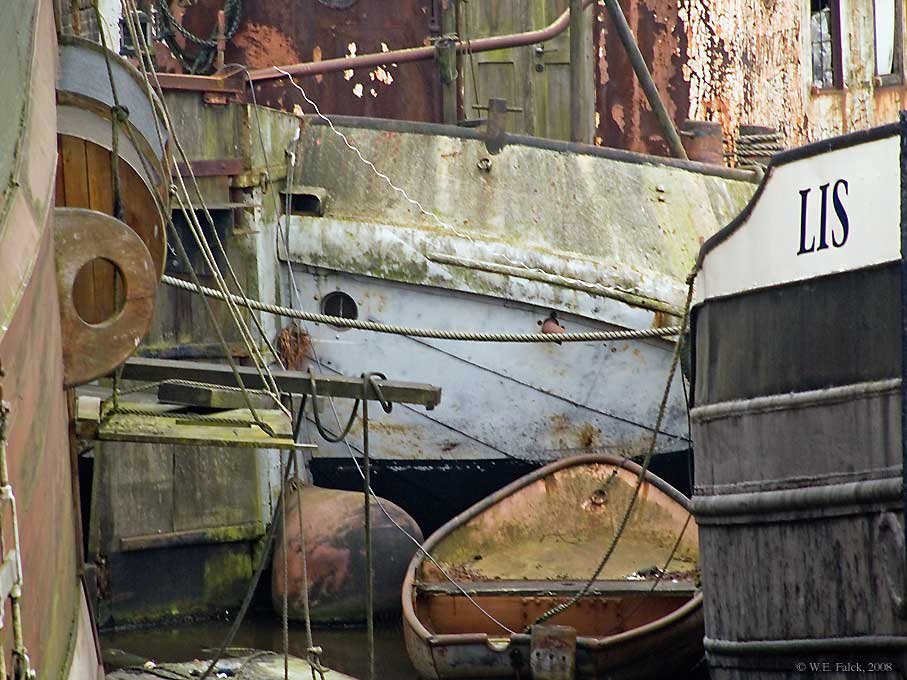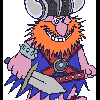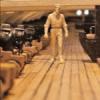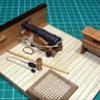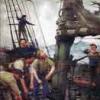Supplies of the Ship Modeler's Handbook are running out. Get your copy NOW before they are gone! Click on photo to order.
×
-
Posts
6,407 -
Joined
-
Last visited
Reputation Activity
-
 wefalck got a reaction from WackoWolf in Proxxon Mini Lathe DB-250 - Opinions/assessments/recommendations?
wefalck got a reaction from WackoWolf in Proxxon Mini Lathe DB-250 - Opinions/assessments/recommendations?
It is quite amazing what skilled mechanics can do with a file (and time) … I am only self-taught, learned things by doing (and reading a few books).
For the lever-tailstock, no other modifications to the existing tailstock, but drilling a hole somewhere in the lower back of the upright part would be needed. From strips of aluminium as you would get in most DIY stores you can fashion the short link and the longer lever. One would need to somehow connect the existing tailstock runner to the lever. Is the runner solid or has it a bore in the back ? One can drill and tap (on the drill-stand) into the back of the runner (if it is not hardened, which I doubt), file (or bend) a U-shaped bracket from aluminium or plastic and connect the two by long screw. The U-shaped bracket would connect the lever through he screw to the tailstock barrel.
wefalck
-
 wefalck got a reaction from Archi in Proxxon Mini Lathe DB-250 - Opinions/assessments/recommendations?
wefalck got a reaction from Archi in Proxxon Mini Lathe DB-250 - Opinions/assessments/recommendations?
The simple tailstocks of my watchmaking lathes are designed that way ...
Obviously the DB250 was designed to keep manufacturing costs and, hence, retail prices low. Actually, the PROXXON guys are usually quite good in optimising usefulness, manufacturing quality and price. If one upgrades the design-specs, necessarily the prices go up. For the desing-spec of the simple wood-turning lathe, a mis-alignment of the order you described is largely irrelevant. Otherwise the design-guys probably would have come up with a solution as per my sketch right away.
Talking about (simple) modifications: it would be quite easy to convert the tailstock into a lever-action tailstock for drilling along the lines of e.g. the Taig/Peatool one. It needs a few strips of aluminium, a drill, a hacksaw, and a file to make such lever.
PROXXON uses standard stock materials to keep cost down. So I am sure that the tailstock runner is made from standard ground stock and you can replace it easily with material of the same dimensions.
Sorry, I was getting carried away by ideas …
wefalck
-
 wefalck got a reaction from Archi in Proxxon Mini Lathe DB-250 - Opinions/assessments/recommendations?
wefalck got a reaction from Archi in Proxxon Mini Lathe DB-250 - Opinions/assessments/recommendations?
Yes, if it works for the time being, it may not be worth spending more time on it.
If I were to do something about the problems, I perhaps would modify the tailstock a long what is practice in other lathes (see drawing below): I would file a notch under the front of the tailstock barrel, so that I have a completely round section may be about 10 mm long. I then would make a thin saw cut along the centre of the barrel until perhaps half-way down to the notch for the brass nut. Next I would make a clamp (from aluminium, but some tough plastic, such PVC, or even wood would work) that fits tightly around the round section of the barrel. The clamp is slotted and can be tightened with (thumb-)screw just enough to give the tailstock runner a sliding fit in the barrel. The clamp can be used also instead of the thumbscrew on top of the barrel to lock the runner in position.
These modifications would likely change the need to shim the tailstock, so should be done first.
I may also file the nut a bit thinner and put a spring washer in front of it, but this would depend on how much end-play you have, when the runner is not locked.
wefalck
-
 wefalck got a reaction from WackoWolf in Proxxon Mini Lathe DB-250 - Opinions/assessments/recommendations?
wefalck got a reaction from WackoWolf in Proxxon Mini Lathe DB-250 - Opinions/assessments/recommendations?
Tony, hand-scraping is an old-time, well, art of precision-fitting of machine surfaces. With a chisel-like tool minute amounts of metal are removed until a perfect fit or match has been achieved. More details e.g. here: http://en.wikipedia.org/wiki/Hand_scraper. The 'fitters' at the same time tried to achieve a pleasing looking surface. Today with CNC-precision grinding this craft is only needed for repair or restoration work. I am only a self-taught evening-mechanic, so I don't really master it and rather use a file
I don't have such lathe, so I don't know how the tailstock is actually constructed. Looking at the catalogue picture, I think there is a simple bore going through the tailstock; the barrel presumably is plain in the front part and has a thread cut into the rear part; the brass nut that runs in a slot of the tailstock moves the barrel in and out; the barrel also has a key cut into the top surface; a thumb-screw on top of the tailstock prevents the barrel from turning and also locks it when set. Am I right ? If could post a picture of the disassembled tailstock, perhaps I could give you some ideas how to reduce the side- and end-play of the barrel. Do you have a pillar-drill ?
wefalck
-
 wefalck got a reaction from WackoWolf in Proxxon Mini Lathe DB-250 - Opinions/assessments/recommendations?
wefalck got a reaction from WackoWolf in Proxxon Mini Lathe DB-250 - Opinions/assessments/recommendations?
Well, wood lathes are acctually not really designed for this kind of centre-drilling, that's the domain of metal lathes, even when it is done into wood. The purpose of a wood-lathe is rough centre a piece of wood and then to work it down with chisels. That's why wood-lathes typically are built much more simple (and cheaper). By the same token, a wood-lathe tailstock-barrel (or least the one of the DB250) are not meant to work under load, they are designed to be set and then clamped tight. To work under load, the tailstock bore would have to be ground carefully in line with the headstock to a sliding fit for the barrel - at the price of the lathe this would be impossible.
However, scraping-in (the workmanship method) or filing-in (the amateur's way - I did it as well …) of tailstocks to the bed is possible, if there is enough 'meat'.
wefalck
-
 wefalck got a reaction from michael mott in Zuiderzee-Botter by wefalck - FINISHED - Artitec - RESIN
wefalck got a reaction from michael mott in Zuiderzee-Botter by wefalck - FINISHED - Artitec - RESIN
Thanks again, gentlemen, for your favourable comments.
A fishing boats needs some fish-baskets to store the sorted catch in.
Fish-baskets on the Marker botter in the Zuiderzeemuseum
I could not think a convincing method to fake such baskets and dropped ideas of using fabric or wire mesh – there would always be an unrealistic seam. If you have a closed or filled basket, you may sculpt it from something and imprint the woven pattern, but this does not work for empty ones. In the end, I decided to weave real baskets, well almost.
Tool for making (fish-)baskets
For this I needed a tool that would give the basket its shape and allow me to handle it while weaving. So I turned the little implement above from a piece of 5 mm diameter aluminium and drilled a 2 mm hole all the way through it. It will allow me make two baskets simultaneously. The material for weaving is another issue. I would have like to use wire, but it would have been difficult to actually weave with wire. So I used some thin cotton thread for the stakes and fly-tying yarn for the weave.
Weaving fish-baskets
First the ‚stakes’ were put into place by wind the thread around the form tool in a continuous series of loops, passing the return part through the middle of the center bore of the tool. This then was woven out with the fly-tying yarn using a sewing needle. The rim is a bit of a fake: normally the stakes would be bent back one over each other to produce a stable and decorative finishing. Here I made a double row of half-hitches with the weave, i.e. the fly-tying thread. Once this was finished, the ‚basket’ was soaked in wood stain and then a few dabs of matt varnish were applied to secure the weaving. The stakes with the exception of two on each side then were cut off flush with the rim. The remaining stakes were twisted into looped handles. Finally the stakes were cut around the hole in the bottom of tool. A bottom of the basket was faked by closing the hole with a good drop of white glue.
The finished fish-baskets
The baskets then were weathered using acrylics paint (umbra). After looking at the museum-picture, I noticed that I should paint onto the baskets the registration number of the boat - so that catch can be identified at the fish auction.
One may notice on the above photograph that in the meantime also the anchor, a grab, has been installed. Finding such small chain is a challenge, but I got something suitable from a Bavarian model railway supplier. While the links were nicely soldered and blackend, they were actually round. Anchor chains, however, have oval links. With a pair of pliers I slightly squashed the links into an oval shape.
wefalck
-
 wefalck got a reaction from Salty Sea Dog in The Dutch Boeier De Sperwer- The 'James Bond Yacht'
wefalck got a reaction from Salty Sea Dog in The Dutch Boeier De Sperwer- The 'James Bond Yacht'
Since about the 1840s virtually all iron-work that is exposed to the elements, as well as iron fastenings, was hot-dip zinc-plated. In addition, the iron-work could be painted to suit the decorative scheme of a boat. While this anti-corrosion treatment is quite efficient, when not done very carefully, the plating can be porous, so that the iron can rust underneath. The corrosion products, iron(hydr)oxides, can diffuse into the zinc layer tarnishing it into a yellowish tint. Vice versa, a porous zinc layer can soak up e.g. tar-based paints, making it look yellowish, even when the paint has been removed.
Seawater-resistant bronce would normally not be painted and is indeed not easy to paint, as paint does not very well adhere to this material.
wefalck
-
 wefalck got a reaction from Rudolf in Zuiderzee-Botter by wefalck - FINISHED - Artitec - RESIN
wefalck got a reaction from Rudolf in Zuiderzee-Botter by wefalck - FINISHED - Artitec - RESIN
Thanks again, gentlemen, for the kind words.
***
Time has come to release the botter into its natural habitat ...
The model was fixed to the baseboard by a screw with countersunk head. Where necessary, the loosened ice around the boat was touched up with the same sugar-acrylic gel mixture with which the rest of the ice-scape was modelled.
The next step will be to complete vitrine. Then, work on population of the scenery will continue and a some ‚loose’ equipment for the botter will also have to be made.
wefalck
-
 wefalck got a reaction from druxey in Zuiderzee-Botter by wefalck - FINISHED - Artitec - RESIN
wefalck got a reaction from druxey in Zuiderzee-Botter by wefalck - FINISHED - Artitec - RESIN
Thanks again, gentlemen, for the kind words.
***
Time has come to release the botter into its natural habitat ...
The model was fixed to the baseboard by a screw with countersunk head. Where necessary, the loosened ice around the boat was touched up with the same sugar-acrylic gel mixture with which the rest of the ice-scape was modelled.
The next step will be to complete vitrine. Then, work on population of the scenery will continue and a some ‚loose’ equipment for the botter will also have to be made.
wefalck
-
 wefalck got a reaction from Rudolf in Zuiderzee-Botter by wefalck - FINISHED - Artitec - RESIN
wefalck got a reaction from Rudolf in Zuiderzee-Botter by wefalck - FINISHED - Artitec - RESIN
Thanks again, gentlemen, for your favourable comments.
A fishing boats needs some fish-baskets to store the sorted catch in.
Fish-baskets on the Marker botter in the Zuiderzeemuseum
I could not think a convincing method to fake such baskets and dropped ideas of using fabric or wire mesh – there would always be an unrealistic seam. If you have a closed or filled basket, you may sculpt it from something and imprint the woven pattern, but this does not work for empty ones. In the end, I decided to weave real baskets, well almost.
Tool for making (fish-)baskets
For this I needed a tool that would give the basket its shape and allow me to handle it while weaving. So I turned the little implement above from a piece of 5 mm diameter aluminium and drilled a 2 mm hole all the way through it. It will allow me make two baskets simultaneously. The material for weaving is another issue. I would have like to use wire, but it would have been difficult to actually weave with wire. So I used some thin cotton thread for the stakes and fly-tying yarn for the weave.
Weaving fish-baskets
First the ‚stakes’ were put into place by wind the thread around the form tool in a continuous series of loops, passing the return part through the middle of the center bore of the tool. This then was woven out with the fly-tying yarn using a sewing needle. The rim is a bit of a fake: normally the stakes would be bent back one over each other to produce a stable and decorative finishing. Here I made a double row of half-hitches with the weave, i.e. the fly-tying thread. Once this was finished, the ‚basket’ was soaked in wood stain and then a few dabs of matt varnish were applied to secure the weaving. The stakes with the exception of two on each side then were cut off flush with the rim. The remaining stakes were twisted into looped handles. Finally the stakes were cut around the hole in the bottom of tool. A bottom of the basket was faked by closing the hole with a good drop of white glue.
The finished fish-baskets
The baskets then were weathered using acrylics paint (umbra). After looking at the museum-picture, I noticed that I should paint onto the baskets the registration number of the boat - so that catch can be identified at the fish auction.
One may notice on the above photograph that in the meantime also the anchor, a grab, has been installed. Finding such small chain is a challenge, but I got something suitable from a Bavarian model railway supplier. While the links were nicely soldered and blackend, they were actually round. Anchor chains, however, have oval links. With a pair of pliers I slightly squashed the links into an oval shape.
wefalck
-
 wefalck got a reaction from WackoWolf in Zuiderzee-Botter by wefalck - FINISHED - Artitec - RESIN
wefalck got a reaction from WackoWolf in Zuiderzee-Botter by wefalck - FINISHED - Artitec - RESIN
Thanks for the comments
@Amateur, I still have an unresolved problem with painting the Dutch 'tricolore' on the tiller. My attempts to do it free-hand didn't turn out well. I have to start again with proper masking and the airbrush. The (running) bowsprit was left at home when fishing in the winter. The summer rig would comprise a couple more (rather odd) sails, for which spars would be carried. I only modelled the iron-work that goes with the bowsprit.
wefalck
-
 wefalck got a reaction from mtaylor in Zuiderzee-Botter by wefalck - FINISHED - Artitec - RESIN
wefalck got a reaction from mtaylor in Zuiderzee-Botter by wefalck - FINISHED - Artitec - RESIN
Thanks again, gentlemen, for the kind words.
***
Time has come to release the botter into its natural habitat ...
The model was fixed to the baseboard by a screw with countersunk head. Where necessary, the loosened ice around the boat was touched up with the same sugar-acrylic gel mixture with which the rest of the ice-scape was modelled.
The next step will be to complete vitrine. Then, work on population of the scenery will continue and a some ‚loose’ equipment for the botter will also have to be made.
wefalck
-
 wefalck got a reaction from Dubz in Zuiderzee-Botter by wefalck - FINISHED - Artitec - RESIN
wefalck got a reaction from Dubz in Zuiderzee-Botter by wefalck - FINISHED - Artitec - RESIN
Thanks again, gentlemen, for your favourable comments.
A fishing boats needs some fish-baskets to store the sorted catch in.
Fish-baskets on the Marker botter in the Zuiderzeemuseum
I could not think a convincing method to fake such baskets and dropped ideas of using fabric or wire mesh – there would always be an unrealistic seam. If you have a closed or filled basket, you may sculpt it from something and imprint the woven pattern, but this does not work for empty ones. In the end, I decided to weave real baskets, well almost.
Tool for making (fish-)baskets
For this I needed a tool that would give the basket its shape and allow me to handle it while weaving. So I turned the little implement above from a piece of 5 mm diameter aluminium and drilled a 2 mm hole all the way through it. It will allow me make two baskets simultaneously. The material for weaving is another issue. I would have like to use wire, but it would have been difficult to actually weave with wire. So I used some thin cotton thread for the stakes and fly-tying yarn for the weave.
Weaving fish-baskets
First the ‚stakes’ were put into place by wind the thread around the form tool in a continuous series of loops, passing the return part through the middle of the center bore of the tool. This then was woven out with the fly-tying yarn using a sewing needle. The rim is a bit of a fake: normally the stakes would be bent back one over each other to produce a stable and decorative finishing. Here I made a double row of half-hitches with the weave, i.e. the fly-tying thread. Once this was finished, the ‚basket’ was soaked in wood stain and then a few dabs of matt varnish were applied to secure the weaving. The stakes with the exception of two on each side then were cut off flush with the rim. The remaining stakes were twisted into looped handles. Finally the stakes were cut around the hole in the bottom of tool. A bottom of the basket was faked by closing the hole with a good drop of white glue.
The finished fish-baskets
The baskets then were weathered using acrylics paint (umbra). After looking at the museum-picture, I noticed that I should paint onto the baskets the registration number of the boat - so that catch can be identified at the fish auction.
One may notice on the above photograph that in the meantime also the anchor, a grab, has been installed. Finding such small chain is a challenge, but I got something suitable from a Bavarian model railway supplier. While the links were nicely soldered and blackend, they were actually round. Anchor chains, however, have oval links. With a pair of pliers I slightly squashed the links into an oval shape.
wefalck
-
 wefalck got a reaction from Salty Sea Dog in Zuiderzee-Botter by wefalck - FINISHED - Artitec - RESIN
wefalck got a reaction from Salty Sea Dog in Zuiderzee-Botter by wefalck - FINISHED - Artitec - RESIN
Thanks again, gentlemen, for the kind words.
***
Time has come to release the botter into its natural habitat ...
The model was fixed to the baseboard by a screw with countersunk head. Where necessary, the loosened ice around the boat was touched up with the same sugar-acrylic gel mixture with which the rest of the ice-scape was modelled.
The next step will be to complete vitrine. Then, work on population of the scenery will continue and a some ‚loose’ equipment for the botter will also have to be made.
wefalck
-
 wefalck got a reaction from flying_dutchman2 in Zuiderzee-Botter by wefalck - FINISHED - Artitec - RESIN
wefalck got a reaction from flying_dutchman2 in Zuiderzee-Botter by wefalck - FINISHED - Artitec - RESIN
Thanks again, gentlemen, for the kind words.
***
Time has come to release the botter into its natural habitat ...
The model was fixed to the baseboard by a screw with countersunk head. Where necessary, the loosened ice around the boat was touched up with the same sugar-acrylic gel mixture with which the rest of the ice-scape was modelled.
The next step will be to complete vitrine. Then, work on population of the scenery will continue and a some ‚loose’ equipment for the botter will also have to be made.
wefalck
-
 wefalck got a reaction from hexnut in Zuiderzee-Botter by wefalck - FINISHED - Artitec - RESIN
wefalck got a reaction from hexnut in Zuiderzee-Botter by wefalck - FINISHED - Artitec - RESIN
Thanks again, gentlemen, for the kind words.
***
Time has come to release the botter into its natural habitat ...
The model was fixed to the baseboard by a screw with countersunk head. Where necessary, the loosened ice around the boat was touched up with the same sugar-acrylic gel mixture with which the rest of the ice-scape was modelled.
The next step will be to complete vitrine. Then, work on population of the scenery will continue and a some ‚loose’ equipment for the botter will also have to be made.
wefalck
-
 wefalck got a reaction from flying_dutchman2 in Zuiderzee-Botter by wefalck - FINISHED - Artitec - RESIN
wefalck got a reaction from flying_dutchman2 in Zuiderzee-Botter by wefalck - FINISHED - Artitec - RESIN
Thanks again, gentlemen, for your favourable comments.
A fishing boats needs some fish-baskets to store the sorted catch in.
Fish-baskets on the Marker botter in the Zuiderzeemuseum
I could not think a convincing method to fake such baskets and dropped ideas of using fabric or wire mesh – there would always be an unrealistic seam. If you have a closed or filled basket, you may sculpt it from something and imprint the woven pattern, but this does not work for empty ones. In the end, I decided to weave real baskets, well almost.
Tool for making (fish-)baskets
For this I needed a tool that would give the basket its shape and allow me to handle it while weaving. So I turned the little implement above from a piece of 5 mm diameter aluminium and drilled a 2 mm hole all the way through it. It will allow me make two baskets simultaneously. The material for weaving is another issue. I would have like to use wire, but it would have been difficult to actually weave with wire. So I used some thin cotton thread for the stakes and fly-tying yarn for the weave.
Weaving fish-baskets
First the ‚stakes’ were put into place by wind the thread around the form tool in a continuous series of loops, passing the return part through the middle of the center bore of the tool. This then was woven out with the fly-tying yarn using a sewing needle. The rim is a bit of a fake: normally the stakes would be bent back one over each other to produce a stable and decorative finishing. Here I made a double row of half-hitches with the weave, i.e. the fly-tying thread. Once this was finished, the ‚basket’ was soaked in wood stain and then a few dabs of matt varnish were applied to secure the weaving. The stakes with the exception of two on each side then were cut off flush with the rim. The remaining stakes were twisted into looped handles. Finally the stakes were cut around the hole in the bottom of tool. A bottom of the basket was faked by closing the hole with a good drop of white glue.
The finished fish-baskets
The baskets then were weathered using acrylics paint (umbra). After looking at the museum-picture, I noticed that I should paint onto the baskets the registration number of the boat - so that catch can be identified at the fish auction.
One may notice on the above photograph that in the meantime also the anchor, a grab, has been installed. Finding such small chain is a challenge, but I got something suitable from a Bavarian model railway supplier. While the links were nicely soldered and blackend, they were actually round. Anchor chains, however, have oval links. With a pair of pliers I slightly squashed the links into an oval shape.
wefalck
-
 wefalck got a reaction from dafi in Zuiderzee-Botter by wefalck - FINISHED - Artitec - RESIN
wefalck got a reaction from dafi in Zuiderzee-Botter by wefalck - FINISHED - Artitec - RESIN
Thanks again, gentlemen, for the kind words.
***
Time has come to release the botter into its natural habitat ...
The model was fixed to the baseboard by a screw with countersunk head. Where necessary, the loosened ice around the boat was touched up with the same sugar-acrylic gel mixture with which the rest of the ice-scape was modelled.
The next step will be to complete vitrine. Then, work on population of the scenery will continue and a some ‚loose’ equipment for the botter will also have to be made.
wefalck
-
 wefalck got a reaction from realworkingsailor in Zuiderzee-Botter by wefalck - FINISHED - Artitec - RESIN
wefalck got a reaction from realworkingsailor in Zuiderzee-Botter by wefalck - FINISHED - Artitec - RESIN
Thanks again, gentlemen, for the kind words.
***
Time has come to release the botter into its natural habitat ...
The model was fixed to the baseboard by a screw with countersunk head. Where necessary, the loosened ice around the boat was touched up with the same sugar-acrylic gel mixture with which the rest of the ice-scape was modelled.
The next step will be to complete vitrine. Then, work on population of the scenery will continue and a some ‚loose’ equipment for the botter will also have to be made.
wefalck
-
 wefalck got a reaction from avsjerome2003 in Is this a real ship? "Kiel restaurant"
wefalck got a reaction from avsjerome2003 in Is this a real ship? "Kiel restaurant"
Well, the 'Currywurst' was not 'invented' until after the WWII in Berlin … and normally we don't eat Bratwurst with Sauerkraut, but rather 'Eisbein' (i.e. salted porc knuckle) or fresh liver and blood sausage. The beer, however, was available everywhere at all times for probably a 1000 years or so
wefalck
-
 wefalck got a reaction from hexnut in Zuiderzee-Botter by wefalck - FINISHED - Artitec - RESIN
wefalck got a reaction from hexnut in Zuiderzee-Botter by wefalck - FINISHED - Artitec - RESIN
Thanks again, gentlemen, for your favourable comments.
A fishing boats needs some fish-baskets to store the sorted catch in.
Fish-baskets on the Marker botter in the Zuiderzeemuseum
I could not think a convincing method to fake such baskets and dropped ideas of using fabric or wire mesh – there would always be an unrealistic seam. If you have a closed or filled basket, you may sculpt it from something and imprint the woven pattern, but this does not work for empty ones. In the end, I decided to weave real baskets, well almost.
Tool for making (fish-)baskets
For this I needed a tool that would give the basket its shape and allow me to handle it while weaving. So I turned the little implement above from a piece of 5 mm diameter aluminium and drilled a 2 mm hole all the way through it. It will allow me make two baskets simultaneously. The material for weaving is another issue. I would have like to use wire, but it would have been difficult to actually weave with wire. So I used some thin cotton thread for the stakes and fly-tying yarn for the weave.
Weaving fish-baskets
First the ‚stakes’ were put into place by wind the thread around the form tool in a continuous series of loops, passing the return part through the middle of the center bore of the tool. This then was woven out with the fly-tying yarn using a sewing needle. The rim is a bit of a fake: normally the stakes would be bent back one over each other to produce a stable and decorative finishing. Here I made a double row of half-hitches with the weave, i.e. the fly-tying thread. Once this was finished, the ‚basket’ was soaked in wood stain and then a few dabs of matt varnish were applied to secure the weaving. The stakes with the exception of two on each side then were cut off flush with the rim. The remaining stakes were twisted into looped handles. Finally the stakes were cut around the hole in the bottom of tool. A bottom of the basket was faked by closing the hole with a good drop of white glue.
The finished fish-baskets
The baskets then were weathered using acrylics paint (umbra). After looking at the museum-picture, I noticed that I should paint onto the baskets the registration number of the boat - so that catch can be identified at the fish auction.
One may notice on the above photograph that in the meantime also the anchor, a grab, has been installed. Finding such small chain is a challenge, but I got something suitable from a Bavarian model railway supplier. While the links were nicely soldered and blackend, they were actually round. Anchor chains, however, have oval links. With a pair of pliers I slightly squashed the links into an oval shape.
wefalck
-
 wefalck got a reaction from BANYAN in Zuiderzee-Botter by wefalck - FINISHED - Artitec - RESIN
wefalck got a reaction from BANYAN in Zuiderzee-Botter by wefalck - FINISHED - Artitec - RESIN
Thanks again, gentlemen, for your favourable comments.
A fishing boats needs some fish-baskets to store the sorted catch in.
Fish-baskets on the Marker botter in the Zuiderzeemuseum
I could not think a convincing method to fake such baskets and dropped ideas of using fabric or wire mesh – there would always be an unrealistic seam. If you have a closed or filled basket, you may sculpt it from something and imprint the woven pattern, but this does not work for empty ones. In the end, I decided to weave real baskets, well almost.
Tool for making (fish-)baskets
For this I needed a tool that would give the basket its shape and allow me to handle it while weaving. So I turned the little implement above from a piece of 5 mm diameter aluminium and drilled a 2 mm hole all the way through it. It will allow me make two baskets simultaneously. The material for weaving is another issue. I would have like to use wire, but it would have been difficult to actually weave with wire. So I used some thin cotton thread for the stakes and fly-tying yarn for the weave.
Weaving fish-baskets
First the ‚stakes’ were put into place by wind the thread around the form tool in a continuous series of loops, passing the return part through the middle of the center bore of the tool. This then was woven out with the fly-tying yarn using a sewing needle. The rim is a bit of a fake: normally the stakes would be bent back one over each other to produce a stable and decorative finishing. Here I made a double row of half-hitches with the weave, i.e. the fly-tying thread. Once this was finished, the ‚basket’ was soaked in wood stain and then a few dabs of matt varnish were applied to secure the weaving. The stakes with the exception of two on each side then were cut off flush with the rim. The remaining stakes were twisted into looped handles. Finally the stakes were cut around the hole in the bottom of tool. A bottom of the basket was faked by closing the hole with a good drop of white glue.
The finished fish-baskets
The baskets then were weathered using acrylics paint (umbra). After looking at the museum-picture, I noticed that I should paint onto the baskets the registration number of the boat - so that catch can be identified at the fish auction.
One may notice on the above photograph that in the meantime also the anchor, a grab, has been installed. Finding such small chain is a challenge, but I got something suitable from a Bavarian model railway supplier. While the links were nicely soldered and blackend, they were actually round. Anchor chains, however, have oval links. With a pair of pliers I slightly squashed the links into an oval shape.
wefalck
-
 wefalck got a reaction from avsjerome2003 in Gjoa Build Idea - How do you make a ship look so cold it makes you shiver?
wefalck got a reaction from avsjerome2003 in Gjoa Build Idea - How do you make a ship look so cold it makes you shiver?
You may want to have a look at my building-log on a Dutch botter frozen-in at the Volendam harbour: http://modelshipworld.com/index.php?/topic/68-zuiderzee-botter-by-wefalck-artitec-resin/?p=80030
The materials used are finely ground sugar and acrylic gel resp. varnish.
wefalck
-
 wefalck got a reaction from dafi in Zuiderzee-Botter by wefalck - FINISHED - Artitec - RESIN
wefalck got a reaction from dafi in Zuiderzee-Botter by wefalck - FINISHED - Artitec - RESIN
Thanks again, gentlemen, for your favourable comments.
A fishing boats needs some fish-baskets to store the sorted catch in.
Fish-baskets on the Marker botter in the Zuiderzeemuseum
I could not think a convincing method to fake such baskets and dropped ideas of using fabric or wire mesh – there would always be an unrealistic seam. If you have a closed or filled basket, you may sculpt it from something and imprint the woven pattern, but this does not work for empty ones. In the end, I decided to weave real baskets, well almost.
Tool for making (fish-)baskets
For this I needed a tool that would give the basket its shape and allow me to handle it while weaving. So I turned the little implement above from a piece of 5 mm diameter aluminium and drilled a 2 mm hole all the way through it. It will allow me make two baskets simultaneously. The material for weaving is another issue. I would have like to use wire, but it would have been difficult to actually weave with wire. So I used some thin cotton thread for the stakes and fly-tying yarn for the weave.
Weaving fish-baskets
First the ‚stakes’ were put into place by wind the thread around the form tool in a continuous series of loops, passing the return part through the middle of the center bore of the tool. This then was woven out with the fly-tying yarn using a sewing needle. The rim is a bit of a fake: normally the stakes would be bent back one over each other to produce a stable and decorative finishing. Here I made a double row of half-hitches with the weave, i.e. the fly-tying thread. Once this was finished, the ‚basket’ was soaked in wood stain and then a few dabs of matt varnish were applied to secure the weaving. The stakes with the exception of two on each side then were cut off flush with the rim. The remaining stakes were twisted into looped handles. Finally the stakes were cut around the hole in the bottom of tool. A bottom of the basket was faked by closing the hole with a good drop of white glue.
The finished fish-baskets
The baskets then were weathered using acrylics paint (umbra). After looking at the museum-picture, I noticed that I should paint onto the baskets the registration number of the boat - so that catch can be identified at the fish auction.
One may notice on the above photograph that in the meantime also the anchor, a grab, has been installed. Finding such small chain is a challenge, but I got something suitable from a Bavarian model railway supplier. While the links were nicely soldered and blackend, they were actually round. Anchor chains, however, have oval links. With a pair of pliers I slightly squashed the links into an oval shape.
wefalck
-
 wefalck got a reaction from tarbrush in Zuiderzee-Botter by wefalck - FINISHED - Artitec - RESIN
wefalck got a reaction from tarbrush in Zuiderzee-Botter by wefalck - FINISHED - Artitec - RESIN
It is high time to report on some progress. The work progressed slowly, interrupted by various business travels and also a short hospital-stay.
Head of the main sail from starboard
The main sail was fitted out with the halliard and the throat-halliard and then attached. The imagined szenario is that the sails are set for drying. The shore of Volendam is exposed to the East, so that the sails are slightly filled by a light easterly breeze. The cold easterly breeze, that comes across from Germany and the Baltic was a winterstorm a couple of days ago and forced the botter to seek shelter in Volendam. The easterly wind brought with it the frost that is responsible for the Marker botter to be locked in the ice. The main boom has been topped a bit to provide better clearance in the workspace underneath.
Head of the main sail from port
In the meantime various ropes of different size were made from fly-tying thread. Then I also noticed that I forgot to make that special block with a half-cleat that forms the lower part of the main sheet tackle. This block was carved in the classical way from a strip of Pertinax and fitted out with an ‚iron’ band etc.
Running rigging at the mast
Running rigging at the mast
The running rigging was attached by fake eye-splices. On the prototype, all blocks are attached to eye-bolts by hooks, which are secured by musings. The pictures do not show this detail yet. Owing to this way of rigging, all tackles could be prepared in advance and just hooked into their respective eye-bolts. The throat-halliard is made up from a short length of chain with an S-hook at its end. The S-hook is attached to the eye in the bolt-rope. The throat-halliard is hauled taught with a tackle that hooks into an eye-bolt in the mast. The S-hook was made from a short length of wire that was flattenend and provided with a hole in the middle for a chain-link.
Stern with boom-sheet
Stern with boom-sheet
The halliards etc. were belayed prototype-fashion on half-cleats, which is rather difficult to do at this small scale in comparison to the same process on normal cleats. The rest was coiled up and stored at suitable places. I am not sure how this was done really on the prototype, as the half-cleat do not allow to suspend the coils in the usual way. The rope made from fly-tying yarn is relatively stiff. However, with a drop of flat varnish it can be persuaded to form more or less orderly coils. Hanging coils have to be loaded while the varnish dries in order to attain a natural shape.
Shaping of the coils while the varnish dries
In order to facilitate the work on the rigging the model was fixed on a small cast-iron stand. This stand can be turned and pushed around on the work-table at one’s convenience, yet is stable and safe.
Model on the work-stand
To be continued ...
wefalck

